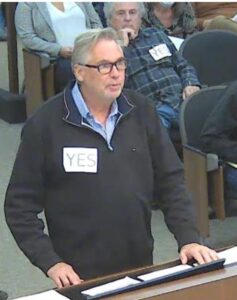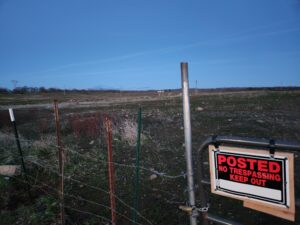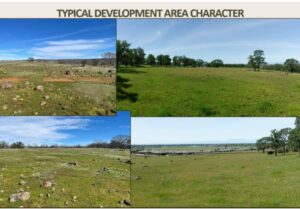Part I in a two-part series on a project that may take more than 20 years to build out
Chico is known to be severely lacking housing most residents can reasonably afford -– and yet an ambitious project the city has approved to develop housing near the foothills has garnered significant pushback.

On Jan. 3, Chico’s City Council greenlit the Valley’s Edge project. Today, national and regional environmental organizations filed a lawsuit to stop Valley’s Edge, alleging that the environmental impact report is out of compliance with the California Environmental Quality Act. The coalition that filed suit, including AquAlliance, the Center for Biological Diversity and the Sierra Club, issued a statement saying they were suing the City of Chico and Chico Land Investments LLC “for approving a development … without properly assessing or mitigating wildfire and other environmental risks.”
(ChicoSol has posted an in-depth story explaining the lawsuit and environmental issues here.)
The City Council vote followed a public hearing on the plan to use the 1,448-acre site, east of city limits between Stilson Canyon Road and Honey Run Road. It’s pitched as a marriage between open space and housing, near the foothills, as a way to increase future housing opportunities in Chico.
The Valley’s Edge project garnered much controversy in the months before the final hearing. Some oppose building so much housing close to the foothills in a diverse ecological zone, and others oppose the site being zoned for housing that is unlikely to be affordable for the average Chico resident. The project approved by the City Council has been under negotiation between the developer and the city for more than a decade.

The City Council is also in receipt of a local public interest law firm’s opposition. And an opposition group is gathering signatures in hopes of holding a referendum.
Housing for all?
Debate over Valley’s Edge has centered on whether it will produce enough of the housing that Chico desperately needs.
The development is proposed by real estate broker Bill Brouhard of Guillon-Brouhard Commercial Real Estate, who has been involved in many of Butte County’s largest residential, office and industrial projects. Brouhard has a long history of influence, serving on the Butte County Economic Development Corporation board, along with time on the boards of directors for the Chico Economic Planning Corporation, the Butte Community Builders Association and the Chico Chamber of Commerce. He pitched Valley’s Edge on land he and his partners own as a boon for future Chico development.
The sloped, lava-cap heavy site is expected to be home for up to 2,777 housing units. The city noted a 2020 Butte County Association of Governments study projecting Chico will need nearly 12,000 more units by 2040, and said Valley’s Edge establishes diverse land use designations. City Planner Mike Sawley says it could take 20 to 40 years to fully build out the site and bring in approximately 5,564 residents. The entire site must be annexed into the city.

But the majority of the land designed to contain housing, specifically about 491 acres, is zoned for very low and low density residential housing. Only 109 acres are zoned as medium density (6 to 14 units per acre) and medium-high density (14 to 22 units per acre). The village core and village commercial areas offer about 56 acres for other development (up to 35 units per acre).
Only 4 acres, or 0.6% of the site, is set aside for legally affordable housing or ‘below market rate’ housing. But Brouhard said the land is zoned so that more than 4 acres could accommodate proposals for more affordable housing.
“Below-market housing can be accommodated in all residential and commercial areas, except the 157 acres designated for estate lot custom homes,” Brouhard said in an email interview.
Later Brouhard was asked again to comment on the lack of affordable housing in Chico. ChicoSol received comments in response by email, stating that the “Valley’s Edge opinion” is that “affordability in a community is driven more by supply and demand than by mere density … Builders don’t build housing that doesn’t sell …. Opposition claims that homes would not be affordable are baseless and unfounded.”
For now, it is unclear what housing types will actually be built and what their price range will be until housing developers make proposals to the city. The city planner said that higher construction costs will be “unavoidable” due to the site’s lava cap geology.
Project opponents worry that Valley’s Edge will be built to lure affluent Bay Area residents to Chico who can work remotely or retire. In one comment letter sent to the Planning Commission, a Chico woman who supports the project says she was born and raised here and notes that “Chico is in dire need of housing.”
“I work remotely now and that trend is not going away,” says Heidi Musick. “Families are flocking to communities outside of metro areas. Chico will become the destination for remote workers of Sacramento, the Bay Area, and Southern California.”
When asked how and if the city will encourage affordable housing on the site, Sawley said, “I’m not sure when the city could ever guarantee that any specific type of development will occur on private lands.”
Sawley said the designated 4-acre site is “as close as it comes to an assurance that the site or units will be provided by the developer.”
Legal Services of Northern California, a legal aid organization embroiled in litigation alleging the city is violating the rights of unhoused people living in public spaces, opposes the project, saying it does not meet the city’s legal obligation to provide enough affordable housing.
A letter by LSNC Managing Attorney Kate Wardrip calls for Chico to adopt a compliant Housing Element and require the developer to plan more sites on the land and to facilitate housing that is affordable for low and very low income households. Valley’s Edge is situated in the Doe Mill/Honey Run planning area which has the lowest poverty status and lowest level of racial integration, combined with the highest amount of community resources such as access to schools, transportation and businesses.
The legal agency alleges that because the project focuses development in a “high opportunity area,” Valley’s Edge will perpetuate economic and racial segregation by concentrating low-density housing that will be largely market-rate priced -– positioning the area out of reach for lower-income residents. Wardrip said the state has projected that within the next eight years, Chico must develop more than 3,400 homes — with 46% designated as affordable for lower-income residents. The state Regional Housing Needs Allocation says that’s about 1,608 low and very low income-priced homes.
About 22% of Chico residents live in poverty, according to the latest U.S. census data. The median household earns $60,500 (in 2021 dollars, likely worsened in 2022 due to inflation), placing Redfin’s median home cost of $423,000 out of reach for the average resident. The city’s highest median price hit $500,000 in May 2022.
Wardrip said Chico’s Housing Element (the current version being 2014-2022 in the 2030 General Plan) is not consistent with state law. Therefore, she argues, Valley’s Edge is being approved while the Element is out of compliance.
The law firm says California’s Department of Housing and Community Development sent the city a letter on Dec. 5 saying the draft element that was due in June must be revised. LSNC said that the city should not accept the Valley’s Edge project while its old Housing Element is still under revision to meet state law.
“The city should use this opportunity to plan meaningfully for housing for low-income people in the Doe Mill / Honey Run specific planning area.” Wardrip wrote. “It is concerning to see the city adopt such a large plan that for the most part ignores the need for affordable housing while the city has yet to adopt a Housing Element compliant with state law.”
A list of promises
The Planning Commission cleared the way on Dec. 1, voting 5-2 to recommend certifying the plan’s environmental impact report (EIR) with a statement of overriding considerations and to approve the Valley’s Edge Specific Plan.
“Opposition claims that homes would not be affordable are baseless” — Valley’s Edge team
The plan includes a community park alongside bikeways and walking trails, as well as a site for a new school and village commercial zone. Brouhard said via email that the plan has converted 732 acres of otherwise unprotected land to open space, of which 455 acres are intended for public use.
However, opponents say only some land will be accessible, and the rest open only to people who someday own homes in the development. The Homeowners’ Association will manage some natural areas and the city will not require those to be open to the public, according to Sawley.
The city also did not find indications of the presence of Native American cultural resources at the site. Sawley said the city did not hear any objection from the tribe that responded to them, the Mechoopda Indian Tribe, after contacting eight tribes about the project’s proximity to known ethnographic villages. The tribe did not respond to a ChicoSol request to verify this.
‘We just gave it away’
Addison Winslow, the sole City Council opponent to Valley’s Edge, pushed city staff and Council for a more robust discussion before the project was approved. He said he thinks the other Council members prioritized a prestigious real estate project designed for wealthy home buyers over affordable housing the city really needs.

“It’s not driven by a long term economic strategy, it’s driven by the short term profitability on behalf of a small number of developers and realtors,” Winslow said.
“We just gave it away …” – Councilmember Addison Winslow
He said he thinks the rest of the Council does not seem to understand the new state laws around approving housing more people can afford. Much of California has overproduced housing that is market-rate priced, but lacks a range of lower-priced housing. Winslow said the city has historically approved placing single family homes in medium density-zoned areas, so little of the development is likely to lead to more dense housing.
“On every (housing) measure, it fails,” he said of Valley’s Edge.
Those who agree with Winslow are pushing for a referendum on the project. Valley’s Edge Resistance is gathering signatures within the next month, and is led by Smart Growth Advocates. The group’s mission according to a vision statement is to “build a sustainable, compact, energized community responsive to the needs of its inhabitants, while also protecting the wildlands and farmlands that surround us.”

Organizer Jared Geiser said Valley’s Edge as “suburban sprawl” is a “pretty irresponsible use of the land.” He wants to see the land returned to indigenous tribes with its biodiversity maintained –- rather than development that creates “an automobile-dependent city.”
“I don’t see a need to sprawl so far from the urban core to produce more housing,” Geiser said. He pointed out about 15 “opportunity” sites –- such as on Park Avenue and Fair Street, identified in the 2030 General Plan land use element -– that could be used to create “moderately-priced housing” instead.
About 5,700 registered Chico voters need to sign the referendum by Feb. 11 to submit a petition by Feb. 13. That would pause the project for one year, after which City Council can determine if the referendum was correct, or hold a special election –- with costs covered by the developer.
Brouhard’s team sounds unhappy about that effort. “We believe any further effort to delay it is unreasonable and will unfairly punish Chico residents wishing to own homes by limiting choice resulting in higher home prices,” Valley’s Edge staff wrote in an email.
Winslow, meanwhile, worries that Chico is missing chances to meet its most pressing housing needs.
“This is getting in the way of us meeting our housing needs,” he said. “We only have so much land available, and we just gave it away … because the Council seems to feel like they’re being offered something special by Bill Brouhard.”
Leslie Layton contributed reporting to this story.

Excellent article! Another issue with this project is that it will result in more automobile congestion. Just about everyone living in this monstrous development will have cars. The bus system is terrible, but the conservative majority on the city council that voted for this does nothing to improve the bus system.
Nice article on Chico’s proposed ‘sprawl’. Hope to see if the signature gathers have reached their goal and approved by SoS. Now that Chico has city council district’s, it’s time to organize and run 3 qualified candidates to join Addison Winslow and his like-minded POV of Chico and Butte Co.